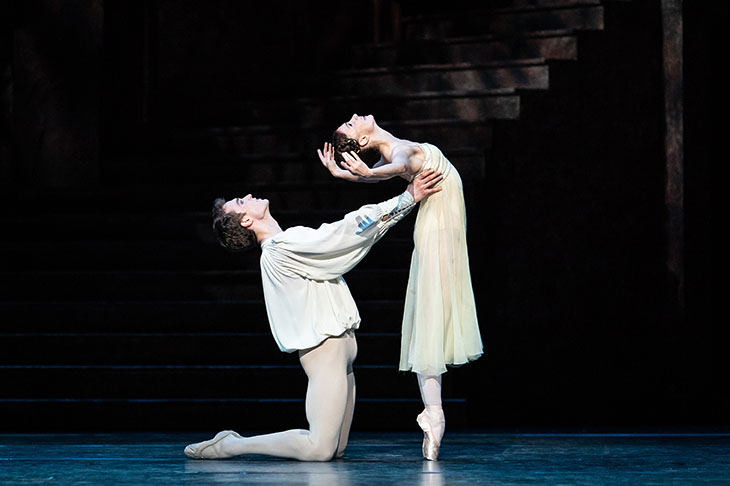Two households, both alike in dignity. Capulets in red tights, Montagues in green. Kenneth MacMillan’s Romeo and Juliet opens in a piazza where the clash of swords makes a fifth section of the orchestra. Strings, woodwind, brass, percussion… and steel. If Shakespeare’s young bloods and blades once seemed remotely Renaissance, made romantic by distance, Verona’s knife-crime crisis is now horribly real and present.
Romeo, Mercutio and Benvolio (Matthew Ball, Valentino Zucchetti and James Hay) make a convincing gang: pumped-up, freewheeling, anarchic. They goose the harlots, twit the nurse and goad each other in reckless acts of lads, lads, lads bravado. Their bragging, ragging gatecrashers’ dance is a tour de force. Zuchetti is Mercutio the wind-up merchant: swift, hot-headed, drunk on his own machismo. Hay, a quick, witty, sportive dancer, sets a let-me-at-’em pace as Benvolio. He is in danger here, as he was in Frankenstein, of upstaging the hero. It is Marcelino Sambé, though, as the lead Mandolin, who dances them into a cocked biretta. Sambé is a double-espresso dancer, all leapfrogging grace and caffeine-high hits.
Against this terrific trio, Matthew Ball’s Romeo is subdued. His lines are elegant, his leaps assured, but he is too introspective. His fleetness, his handsome, expressive gestures are perfectly princely, but there is a failure to connect: both with his Juliet (Lauren Cuthbertson — exceptional) and with his audience. At times he flares bright. His excitement and boyish delight in the balcony scene, as he realises Juliet isn’t another piazza pick-up but the real deal, are palpable. Their first lifting, lilting kiss is the stuff of teenage dreams. But all too often Ball’s mind seems elsewhere.
Juliet is an ingénue with an edge. Whether Cuthbertson is dancing Alice in Alice’s Adventures in Wonderland or the Young Girl in The Two Pigeons, she is playful and curious without ever tipping over to twee. When Juliet is presented to Paris (Ryoichi Hirano), she flirts, falters and flees. She is happier dancing with her doll or her nurse than with her suitor. In this early scene, Juliet’s movements are closed and curtailed. But when she meets Romeo at the Capulet ball, Cuthbertson’s Juliet becomes loose, expansive, sweeping. It’s a marvellous transformation from shy, sulking girlhood to passionate awakening.
The costumes by Nicholas Georgiadis, channelling Benozzo Gozzoli, are sumptuous. Something must be done, though, about the harlots’ Ronald McDonald wigs. The Dance of the Knights remains, on this the 485th performance, a masterclass of menace and magnificence.
Russell Maliphant’s The Thread is loosely wound round the myth of the Minotaur. Our star-crossed lovers are Theseus and Ariadne in a telling that is more abstract than narrative. In Maliphant’s arresting choreography we trace snake-like patterns and Greek key friezes. The Thread opens with the dancers tightly twisted in a central coil. As the music by the Greek composer Vangelis builds, the dancers unspool, winding a labyrinth across the stage. The effect is hypnotic, like watching a cobra swaying and sinking to a snake charmer’s tune. Maliphant has broken briefly from his own company to work with 18 Greek dancers: 12 contemporary and six traditional. In one spellbinding vignette, the music falls silent and a male dancer stamps a spotlit solo. The beat of his boots is all we hear. Better than Vangelis’s pounding trance. The costumes by Mary Katrantzou, born in Athens and trained at Central Saint Martins, are tremendous. If Aphrodite shopped on Net-a-Porter…
I promised myself no My Big Fat Greek Zorba’s Dance jokes, but there were line-dancing moments when, to the untutored eye, it all went a bit spanakopita. At 75 minutes, the piece is 15 minutes too long. Where was the one-eye Fate to snip the hanging thread?







Comments